1/ Il genocidio culturale degli armeni (dal sito del Memoriale del genocidio degli armeni) 2/ La mappa interattiva Multi-Cultural Heritage of Anatolia Project Interactive Map 3/ Stato attuale di monasteri e chiese armeni abbandonati a motivo del genocidio presenti in territorio turco (da Wikipedia) 4/ Testo in inglese da noi tradotto
- Tag usati: armeni, genocidio_armeni
- Segnala questo articolo:
1/ Il genocidio culturale degli armeni (dal sito del Memoriale del genocidio degli armeni)
Riprendiamo e traduciamo dal sito del Memoriale del genocidio degli armeni la pagina dedicata al genocidio culturale e alla distruzione dei monumenti armeni in Turchia, con le foto annesse. Restiamo a disposizione per l’immediata rimozione se la sua presenza sul nostro sito non fosse gradita a qualcuno degli aventi diritto. I neretti sono nostri ed hanno l’unico scopo di facilitare la lettura on-line. Per approfondimenti sull'Armenia e gli armeni, cfr le sezioni Cristianesimo, ecumenismo e religioni (sotto-sezione Chiese ortodosse) e I luoghi della storia della Chiesa, oltre alla sezione Storia e filosofia.
Il Centro culturale Gli scritti (29/8/2016)
Con il termine di 'genocidio culturale' si intende quell’insieme di atti e misure intrapresi per distruggere la cultura di una nazione o di un gruppo etnico. L’espressione ‘genocidio’ coniata da Raphael Lemkin, non si riferisce così solo allo sterminio fisico di un gruppo nazionale o religioso, ma anche alla sua distruzione nazionale, spirituale e culturale, anche se il concetto di genocidio culturale non è ancora stato accolto nella Convenzione delle Nazioni Unite del 1948 per la prevenzione e la punizione del crimine di genocidio.
Molti fatti, avvenuti in concomitanza con i massacri e le deportazioni degli armeni, attestano chiaramente che il governo dei Giovani Turchi aveva premeditato e pianificato con metodo sistematico la distruzione delle testimonianze materiali della civiltà armena. Comprendendo il ruolo che aveva la Chiesa e la fede cristiana nella nazione armena, massacrò consapevolmente sacerdoti armeni, distrusse chiese, monasteri e altre proprietà della chiesa, insieme con migliaia di manoscritti miniati e di manoscritti medievali.
Un testimone oculare arabo del genocidio degli armeni, Fayez El Husseyn, scrive nelle sue memorie che «dopo i massacri degli armeni, commissioni stabilite dal governo sono state impegnate nella vendita delle proprietà che sono rimaste libera per la morte di coloro che le avevano in possesso. Beni armeni di immenso valore culturale sono stati svenduti ai prezzi più bassi. .. io stesso mi sono recato una volta in una chiesa per vedere come era organizzata la vendita di tali beni. Le porte delle scuole armene erano state chiuse. I turchi hanno utilizzato le pergamene dei libri armeni per confezionare pacchi di formaggio, di datteri, di girasoli”.
Nel 1912 il patriarcato armeno di Istanbul aveva presentato un resoconto delle chiese e dei monasteri in Armenia occidentale (Anatolia orientale) e nell'Impero ottomano. Ve ne erano iscritti più di 2300 tra cui i monumenti paleocristiani unici del IV e V secolo, la maggior parte dei quali sono stati saccheggiati, bruciati e distrutti dai turchi durante il genocidio.
La politica di distruzione adottata dai Giovani Turchi per quanto riguardava il patrimonio storico e culturale armeno è stata continuata dalla Turchia repubblicana: infatti sotto la Repubblica queste reliquie sono state viste come testimoni indesiderati della presenza armena.
Alla fine del 1920, la Turchia ha avviato un processo per cambiare i nomi di alcune località in Armenia occidentale. Attualmente il 90% dei nomi delle città armene – delle città e dei monumenti in territorio turco, l’odierna Turchia orientale che corrisponde all’Armenia occidentale (Anatolia orientale) - sono stati turchizzati. I nomi armeni delle località geografiche sono stati cioè sostituiti con nomi turchi.
Secondo un piano sistematico di distruzione, centinaia di monumenti architettonici armeni sono stati distrutti e tutte le iscrizioni armene sono state cancellate.
Nel 1974 l'UNESCO ha dichiarato che dopo il 1923, di 913 monumenti storici armeni superstiti in Turchia orientale, 464 sono scomparsi completamente, 252 sono in rovina, e 197 hanno bisogno di restauri significativi.
Edifici armeni di valore storico-architettonico sono stati demoliti in maniera costante e progressiva con l’utilizzo di dinamite o sono stati utilizzati come bersagli durante esercitazioni di addestramento militare turco; le pietre ancora intatte sono state utilizzate come materiale da costruzione per altri edifici. In alcuni luoghi rurali, monasteri armeni e chiese servono attualmente come stalle, negozi, club e, in un caso, uno di essi è stato utilizzato anche come prigione. In molti casi il governo turco ha convertito chiese armene in moschee.
Il 18 giugno, 1987, il Consiglio d'Europa ha adottato un decreto in cui al VI punto si afferma che il governo turco deve rispettare e prendersi cura della lingua, della cultura e del sistema educativo della diaspora armena che tuttora vive in Turchia, chiedendo allo stesso tempo un adeguata attenzione per i monumenti armeni che si trovano nel territorio attuale della Turchia.
Purtroppo il genocidio culturale contro il patrimonio armeno sul territorio della Turchia continua...
Appendice al n.1: selezione di immagini e websites sui siti più importanti distrutti e abbandonati
Qui un sito che presenta l'intera città di Ani, antica capitale dell'Armenia medioevale, oggi a pochi metri dal confine della repubblica di Armenia, ma in territorio turco, totalmente abbandonata e con i monumenti che si rovinano di anno in anno senza alcun intervento conservativo. Il sito presenta ogni singolo monumento della città: VirtualAni.
Qui una selezione di immagini dal sito del Memoriale del genocidio armeno che permette un confronto fra lo stato in cui erano diversi monumenti medioevali armeni agli inizi del novecento e lo stato attuale dopo il genocidio (sono ovviamente monumenti sia allora che oggi in territorio turco; diversa è la situazione dei monumenti armeni che si trovavano allora fuori dai luoghi del genocidio perché sotto governo russo, oggi parte della Repubblica Armena indipendente)
---Il Monastero di Horomos X-XI secolo)
Il Monastero di Horomos prima del 1965…
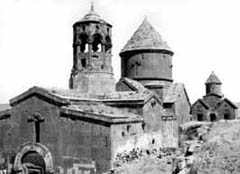
…e nel 1998 (foto S. Karapetian)
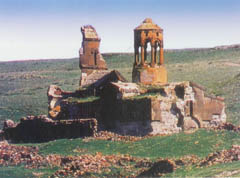
---Ani, Chiesa di Sourb Prkich (S. Salvatore), XI secolo
Nel 1910…
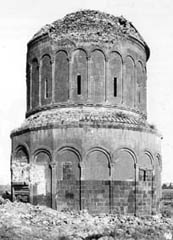
…e nel 2000 (foto S. Karapetian)

---Monastero di Bagnayr, Bagnayr (Ghozluja), XI-XIII secolo
Il Monastero di Bagnayr prima del 1960…
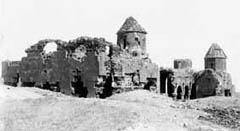
… e nel 2000 (foto S. Karapetian)
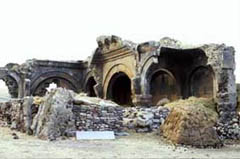
---Monastero di Khtzkonk, VII-XIII secolo
Agli inizi del novecento…
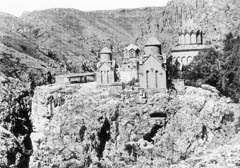
…e dopo l'esplosione nel 1966
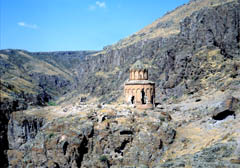
Chiesa superstite del Monastero di Khtzkonk, all'inizio del XX secolo
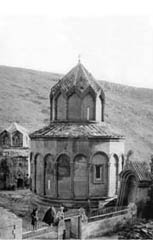
Chiesa superstite del Monastero di Khtzkonk al giorno d'oggi (foto S. Karapetian)
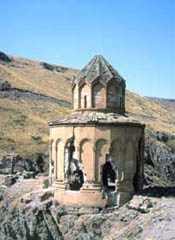
---La Chiesa di Tekor, V secolo
Prima del 1912…

…e nel 2000 (foto S. Karapetian)
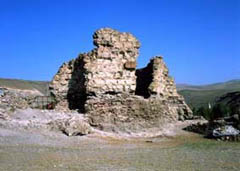
---La chiesa di San Hovhannes di Bagrevand, 613-619
prima del 1966…
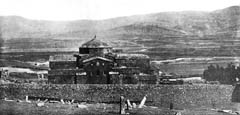
…e nel 2000 (foto S. Karapetian)

---Ani, capitale armena medievale, stemma della città
nel 1910…
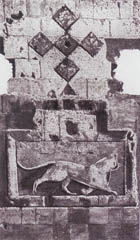
e nel 2000, dopo il restauro turco
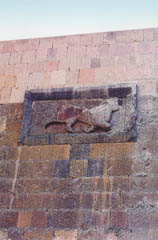
---Van, regione di Aghbak, Monastero di San Bartolomeo Apostolo
Il Monastero, nel 1913…
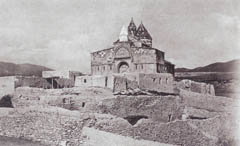
…e nel 1980 (foto A. Hakhnazarian)
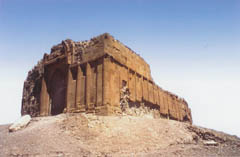
---Van, Eremo di Lim Island, vista nord-orientale
Agli inizi del 1900…
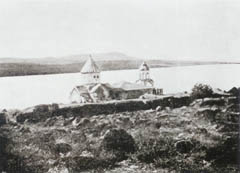
e nel 2004 (foto S. Karapetian)

---Moosh, Monastero di Sb. Arakelots (dei Santi Apostoli), IV-XV secolo
Agli inizi del 1900…
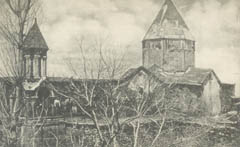
…e nel 2000 (foto S. Karapetian)
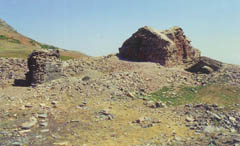
---Moosh, Sb. Monastero Karapet, secoli IV-XVIII, visione occidentale dal lato Sud, 1900
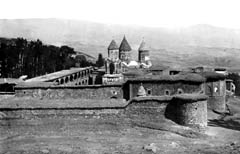
Moosh, villaggio Cankly, sul luogo dell'antico Monastero di Sb. Karapet (foto del 2000, S. Karapetian)
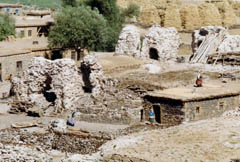
---Van, regione di Rshtoonik (Gevascd), il Villaggio-Monastero di Narek, visione occidentale dal lato Sud,
1900
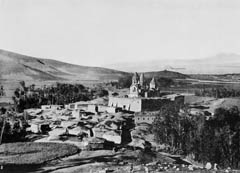
e oggi, con la Moschea costruita sul sito del monastero di Narek distrutto nel 2004 (foto S. Karapetian)
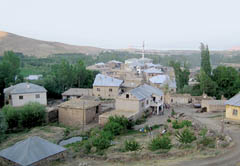
---Van, villaggio di Koghbantz, rovine del Monastero di Salnapat, X-XIII secolo, vista sud-occidentale
1900…
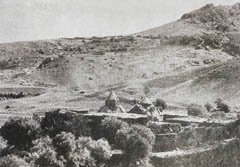
…e 2004 (foto S. Karaperian)
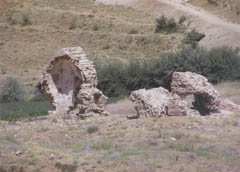
---Van, villaggio di Shoushants, sito del Monastero di Karmravor Sb. Asdvadsadsin, 1900…
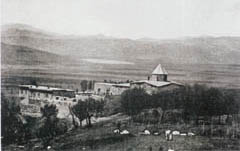
…e 2004 (foto S. Karapetian)
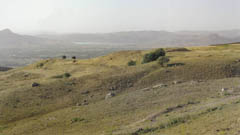
---Van, Monastero Varag, V-XIX secolo,
1900…
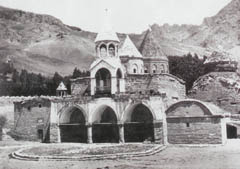
…e 2004 (foto del 2004, S. Karapetian)
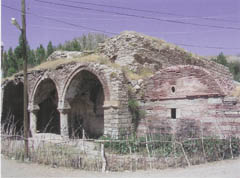
Fonti delle foto: Ricerca sulla distruzione dell'architettura armena, www.raa.am, "L'architettura armena un genocidio culturale" pubblicato dal Comitato nazionale armeno del Canada, Montreal 2005. See more at: http://www.genocide-museum.am/eng/cultural_genocide.php#sthash.IyGtTXHe.dpuf
2/ La mappa interattiva Multi-Cultural Heritage of Anatolia Project Interactive Map
Al link sottostante è possibile navigare sulla Mappa del Progetto interattivo dell’Anatolia che intende mostrare l’eredità multi-culturale del territorio turco.
Il Centro culturale Gli scritti (28/8/2016)
La mappa Multi-Cultural Heritage of Anatolia Project Interactive Map: clicca sul link per navigare e visualizzare le diverse culture che hanno contribuito alla storia dell’Anatolia, territorio oggi appartenente alla Repubblica Turca.
3/ Stato attuale di monasteri e chiese armeni abbandonati a motivo del genocidio presenti in territorio turco (da Wikipedia)
Wikipedia, alla voce Armenian cultural heritage in Turkey, fornisce (il testo che riprendiamo è aggiornato al 22/8/2016; non è stato possibile controllare le singole affermazioni come le didascalie delle foto di Wikipedia) queste informazioni sui principali monasteri e chiese armeni abbandonati a motivo del genocidio.
Il Centro culturale Gli scritti (29/8/2016)
List of notable churches, monasteries
Holy Apostles Monastery
Սուրբ Առաքելոց վանք
Early 20th century image with description
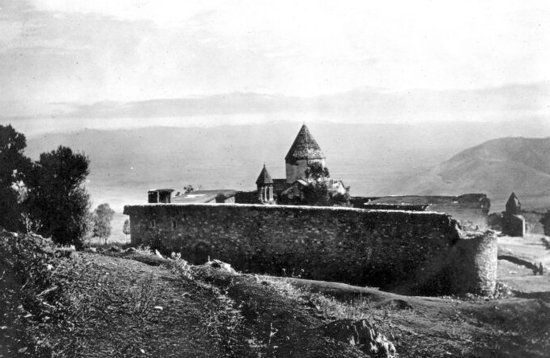
Arakelots Monastery was founded in the 4th century by Saint Gregory the Illuminator to house various relics he received in Rome. Those relics (which included the left arms of Saint Peter and Saint Paul and right arm of the apostle Andrew) account for the monastery's name. During the renewed rule of the Mamikoneans in the post-Byzantine period the monastery became a major cultural and religious centre of Taron. The history of the monastery after the end of Mamikonean rule is mostly one of Muslim raids, massacres, brief periods of abandonment followed by a re-establishment of the monastic community, and short-lived revivals. Under Ottoman rule some stability returned and the fortunes of the monastery rose, but then declined again during the Ottoman-Persian wars of the 17th century. In the 1660s an earthquake damaged most of the buildings. Massacres took place in the mid-1890s, after which the congregation was reduced to only a prior and two or three monks.
Current status with image today
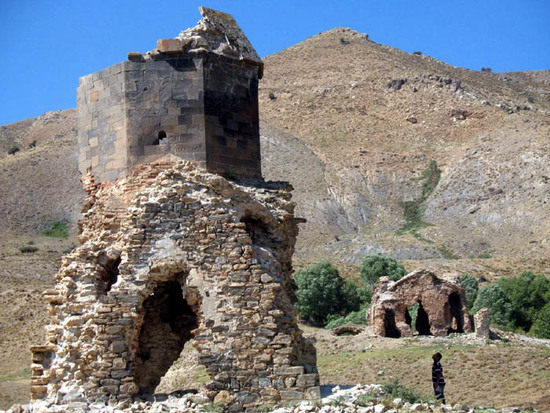
In 1915 the monastery was attacked and looted and its last prior Yovhannes Vardapet Muratian was murdered. One of the double doors of the Monastery (dated 1134) was discovered in Bitlis and had it taken to Tbilisi for safekeeping. The door was later taken to Yerevan in 1925 where is displayed at the History Museum of Armenia.
Saint Karapet Monastery
Մշո Սուրբ Կարապետ վանք
Early 20th century image with description
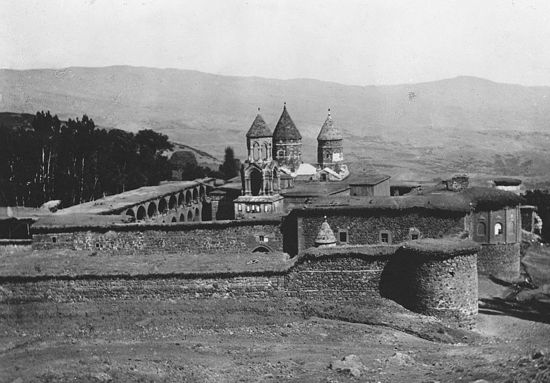
The Saint Karapet Monastery was an Armenian monastic complex in the Taron Province of Greater Armenia, about 35 kilometers northwest of Mush, now in the Kurdish village of Chengeli in eastern Turkey. Founded in the fourth century by Saint Gregory the Illuminator, it was one of the oldest monasteries in Armenia. Saint Karapet Monastery was also one of the three most important sites for Armenian Christian pilgrimage, and among the richest, most ancient institutions in Ottoman Armenia.
Current status with image today
Source: Aztagdaily.com
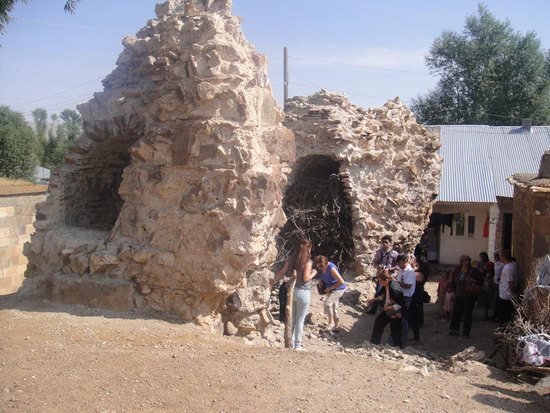
After the Armenian Genocide, it was destroyed to its foundations. It was blown up by the Turkish army several times. Today what remains of Surb Karapet consists of a few shapeless ruins and carved stones and khachkars which have been used as building materials by the current Muslim residents, mostly Kurds, and are often found encrusted in the walls of local homes and structures.
Varagavank [Monastero di Varak ]
Վարագավանք
Early 20th century image with description
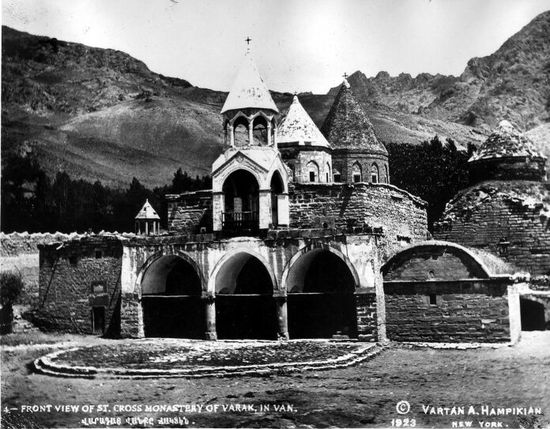
Founded in the early 11th-century on a pre-existing religious site, it was one of the richest and best known monastery's in the Armenian kingdom of Vaspurakan and in later centuries, was the seat of the archbishop of the Armenian Apostolic Church in Van. It was founded by King Senekerim-Hovhannes of the Artsruni Dynasty early in his reign (1003–24) to house a relic of the True Cross that had been kept in a 7th-century hermitage on the same site. The interior form of the central church resembles the designs of the Saint Hripsime church in Armenia. The Armenian archbishops of Van resided here until the late 19th century. Of them, the future Catholicos Mkrtich Khrimian "Hayrik" (Father), founded Artsiv Vaspurakani (The Eagle of Vaspurakan), the first newspaper to be printed in historical Armenia.
Current status with image today
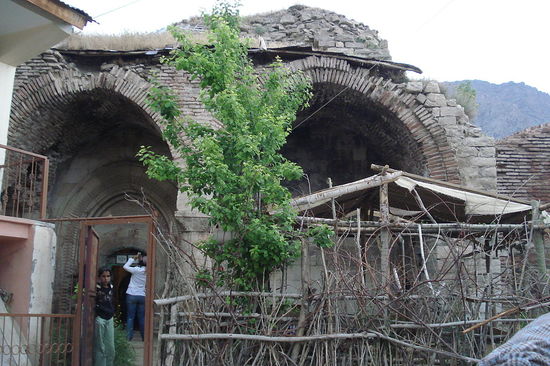
During the Armenian Genocide, on 30 April 1915, the Ottoman army destroyed the monastery during the Siege of Van. Its ruins are still visible in the Kurdish-populated village of Bakraçlı that later developed on the same site. The Monastery is now used as hay storage for domesticated animals.
Narekavank
Նարեկավանք
Early 20th century image with description
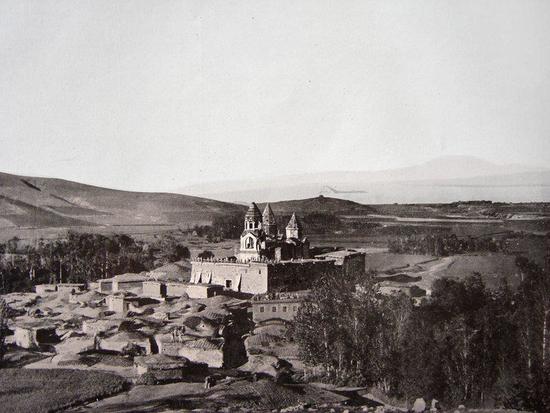
The 10th century Armenian monastery of Narekavank, Lake Van, Vaspurakan (modern Turkey). Early 20th century.
Current status with image today
Completely destroyed
The monastery ceased to function in 1915, during the Armenian Genocide, and was demolished in 1951. The Kurdish-populated village of Yemişlik grew up on the site, and a mosque now stands where the monastery once stood.
Saint Bartholomew Monastery
Սուրբ Բարդուղիմեոսի վանք
Early 20th century image with description
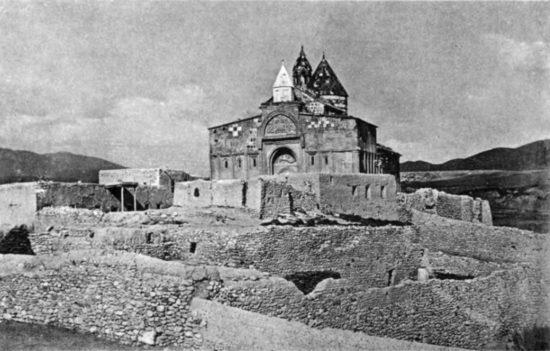
The Saint Bartholomew Monastery was built in the 13th century in what was then the Vaspurakan Province of Greater Armenia, now near the town of Başkale (Albayrak) in the Van Province of southeastern Turkey. It was formerly considered one of the most important pilgrimage sites of the Armenian people. The monastery was built on the traditional site of the martyrdom of the Apostle Bartholomew who is reputed to have brought Christianity to Armenia in the 1st century. Along with Saint Thaddeus, Saint Bartholomew is considered the patron saint of the Armenian Apostolic Church.
Current status with image today
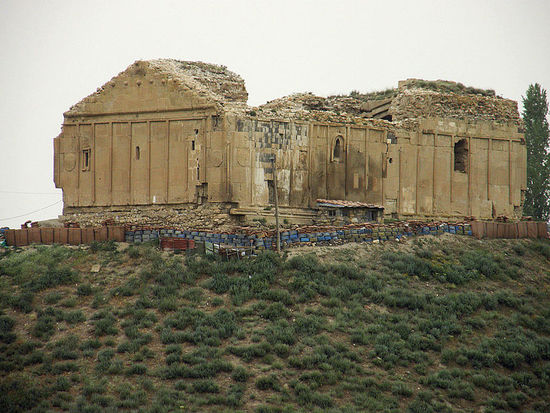
At an unknown date after the Armenian Genocide, the monastery was subjugated under the control of the Turkish military and its entire site now lies within the compound of an army base and its access is restricted. The dome of its church was still intact in the early 1960s, but the whole structure is now very heavily ruined and the dome is entirely gone.
Lim monastery
Լիմ
Early 20th century image with description
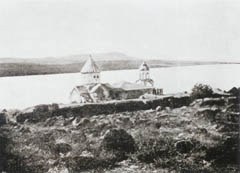
The Armenian Monastery on the island was called St. George or Sourp Kevork. It was built in 1305 and expanded in 1621 and 1766.
Current status with image today
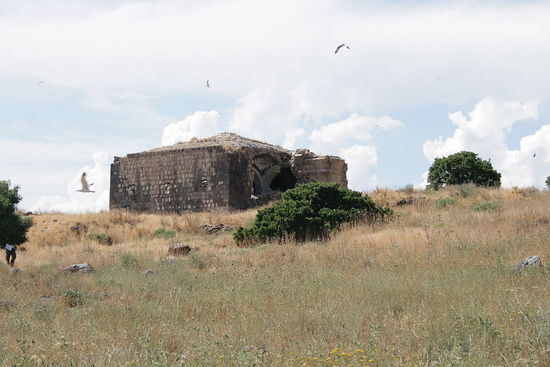
During the Armenian genocide an upwards of 12,000 Armenian women and children, crossed to the isle over a period of three days while a few dozen men covered their retreat from Hamidiye regiments. All starved to death before help could arrive. The Monastery is currently in ruins.
Sourb Nshan of Sebastia
Սուրբ Նշան վանք
Early 20th century image with description

Sourb Nshan monastery was established by prince Atom-Ashot, the son of King Senekerim. The monastery was named after a celebrated relic that Senekerim had brought from Varagavank monastery, and which was returned there after his death. This was one of notable center of enlightenment and scholarship of Lesser Armenia during Byzantine, Seljuk Sultanate of Rum and Ottoman reigns until the Armenian Genocide in 1915. In 1915 Sourb Nshan monastery was the main repository of medieval Armenian manuscripts in the Sebastia region and at least 283 manuscripts are recorded. The library was not destroyed during World War I and most of the manuscripts survived. In 1918 about 100 of them were transferred to the Armenian Patriarchate in Jerusalem.
Current status with image today
Completely destroyed
Source: Armenia. A guidebook.
In 1978, the monastery was demolished with explosives. A military base now occupies the site. No traces of the Monastery remain.
Ktuts monastery
Կտուց
Early 20th century image with description
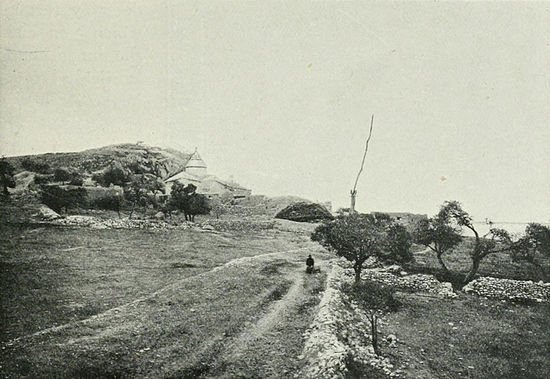
Ktuts monastery, meaning beak in Armenian, is an abandoned 15th century Armenian monastery on the small island of Ktuts (Çarpanak) in Lake Van, Vaspurakan (present-day Turkey). The Ktuts Monastery is situated on a small island in the middle of lake Van, Turkey.
Current status with image today
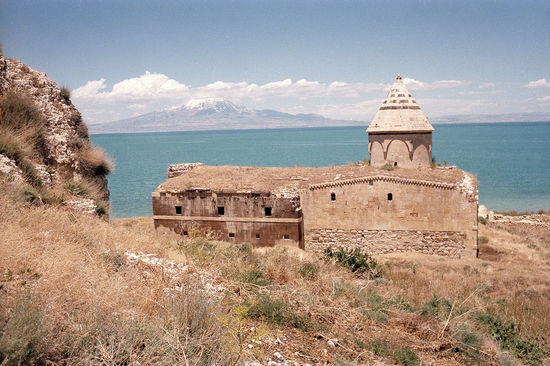
Nowadays, Ktuts monastery appears to be in a better condition than most Armenian monasteries, possibly due to its location. However, there is still overgrowth on the roof due to the fact the monastery has not been maintained since 1915.
Holy Apostles Church
Սուրբ Առաքելոց եկեղեցի
Early 20th century image with description
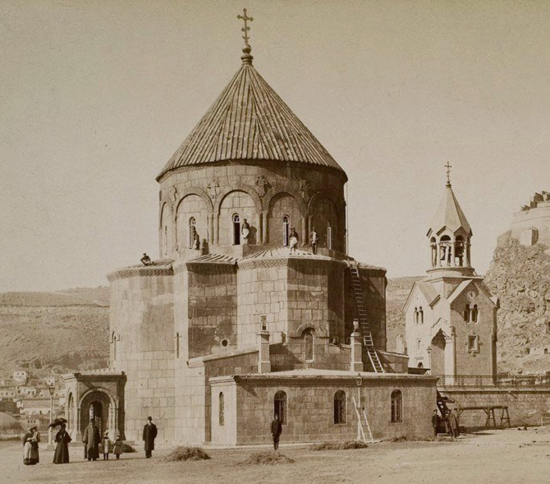
Located in the city of Kars, the Holy Apostles Church completed construction in the 940s during Bagratid Armenia under the rule of Abas I. The Church was called the Holy Apostles Church due to the sculptors of the Twelve Apostles of Jesus located in the exterior of the Church. In 1064 to the 1100s (decade), the Church was converted into a Mosque when it was captured by the Seljuks. Under the Ottoman Empire, the Church was once again converted into a Mosque (1579–1877). After the Russian capture of Kars in 1877 it was converted to a Russian Orthodox church. In 1918, after the fall of Kars to the Turkish army, the cathedral was again turned into a mosque. In 1919, following the retreat of Turks and during the first republic of Armenia, the Cathedral was restored as an Armenian church. In 1920, Kars again fell to Turkey and it ceased to function as a church. It operated briefly as a mosque in the 1920s before being used as a petrol storage depot. It functioned as the Kars Museum between 1969 and 1980.
Current status with image today
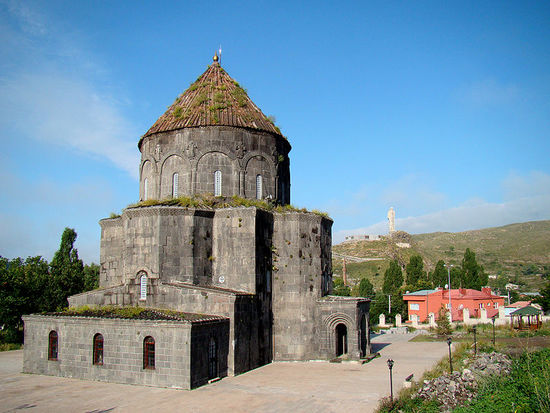
The church was confiscated and became the property of the Turkish state. It has been sold to the local municipality, who planned to demolish it and build a school on the site. The plan never took hold. However, during this time, its bell tower was destroyed. In the 1950s it was used as a depot for petroleum. During the 1960s and 1970s it housed a small museum. The church is currently used as a mosque.
Holy Cross of Aghtamar
Սուրբ Խաչ
Early 20th century image with description
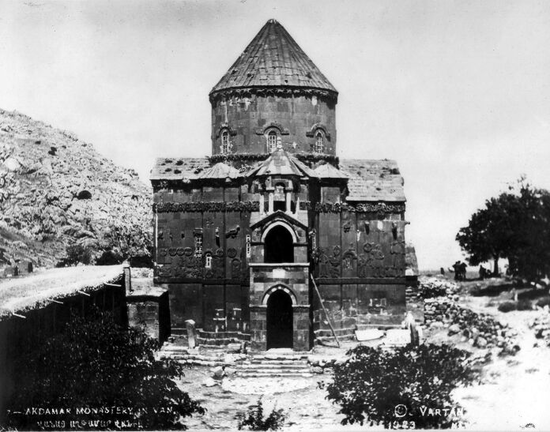
It was order to be built by King Gagik I Artsruni during the years 915–921. It was built of pink volcanic tufa by the architect-monk Manuel with an interior measuring 14.80m by 11.5m and the dome reaching 20.40m above ground. The architecture of the church is based on a form that had been developed in Armenia several centuries earlier; the best-known example being that of the seventh century St. Hripsime church in Echmiadzin. During his reign, King Gagik I Artsruni (r. 908-943/944) of the Armenian kingdom of Vaspurakan chose the island of Aghtamar as one of his residences, founding a settlement there. Between 1116 and 1895 Aght'amar Island was the location of the Armenian Catholicosate of Aghtamar.
Current status with image today
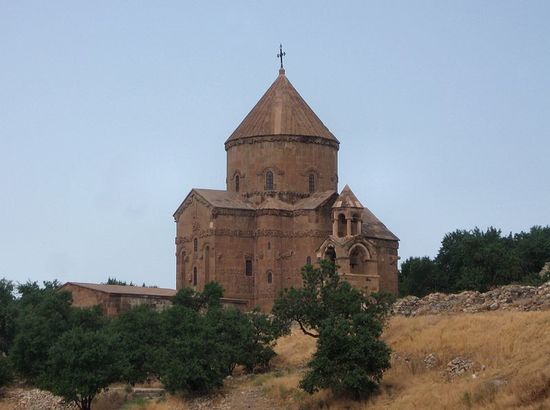
During the Armenian Genocide, the monks of Aghtamar were massacred, the church looted, and the monastic buildings destroyed. The church remained disused through the decades after 1915. After the 1920s, the church was exposed to extensive vandalism. The ornate stone balustrade of the royal gallery disappeared, and comparisons with pre-1914 photographs show cases of damage to the relief carvings. The khatchkar of Catholicos Stephanos, dated 1340, was, by 1956, badly mutilated with large sections of its carvings hacked off. In 1956 only the bottom third of another ornate khachkar, dated 1444, was left – it was intact when photographed by Bachmann in 1911. The 19th-century tombstone of Khatchatur Mokatsi, still intact in 1956, was later smashed into fragments. "In the 1950s the island was used as a military training ground." In 2005 the structure was closed to visitors as it underwent a heavy restoration, being opened as a museum by the Turkish government a year later.
Cathedral of Arapgir
Արաբկիրի մայր եկեղեցի
Early 20th century image with description
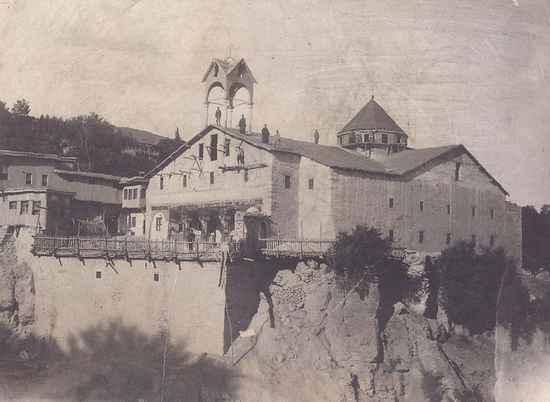
The Cathedral of Arapgir named Holy Mother of God was built in the 13th century. It was one of the biggest churches in Western Armenia. It was able to house 3,000 people. The cathedral was attacked and looted and burnt in 1915 during the Armenian Genocide.
Current status with image today
Completely destroyed
After the Armenian Genocide the cathedral was repaired and was used as a school. In 1950 the Municipality of Arapgir decided to demolish the cathedral. On 18 September 1957 the cathedral was blown up with dynamite. And later, the land where the cathedral stood was sold to a peasant named Hüseyin for 28,005 lira. Today, in place of the cathedral are ruins.
Khtzkonk Monastery
Խծկոնք վանք
Early 20th century image with description
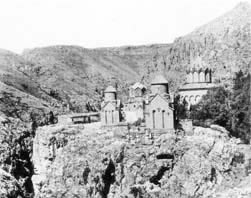
The Khtzkonk Monasteries were a monastic ensemble of five Armenian churches built between the 7th and 13th centuries in what was then the Armenian Bagratid kingdom of Ani. It is now near the town of Digor, the administrative capital of the Digor district of the Kars Province in Turkey, about 19 kilometres west of the border with Armenia. The monastery is located in a gorge formed by the Digor River.
Current status with image today
Source: Panoramio.com
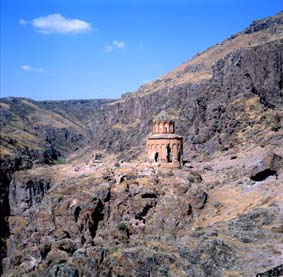
In 1959 the French art historian J. M. Thierry visited the site and found that four of the five churches had been destroyed, with only the Church of Saint Sargis surviving in a badly damaged condition. According to local people, the churches were blown up by the Turkish army using high explosives, which was reaffirmed by citizens of Digor in 2002. Their information is confirmed by the physical evidence on the site. The dome of the surviving church is intact but the side walls have been blown outwards; the destroyed churches have been entirely leveled with their masonry blasted into the gorge below. This is damage that cannot have occurred as a result of an earthquake, historian William Dalrymple remarked.
Church of the Redeemer
Սուրբ Փրկիչ
Early 20th century image with description
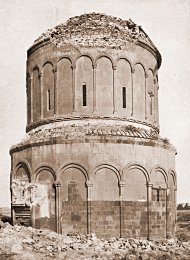
This church was completed shortly after the year 1035. It had a unique design: 19-sided externally, 8-apsed internally, with a huge central dome set upon a tall drum. It was built by Prince Ablgharib Pahlavid to house a fragment of the True Cross.
Current status with image today
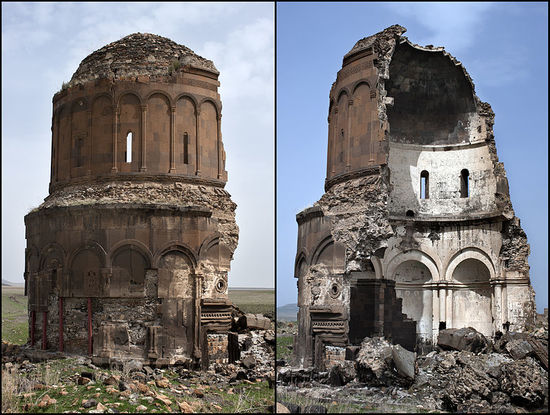
The church was largely intact until 1955, when the entire eastern half collapsed during a storm.
4/ Testo in inglese da noi tradotto al n. 1/
Acts and measures undertaken to destroy any nations’ or ethnic groups’ culture is called, ‘cultural genocide’. The word ‘Genocide’ coined by Raphael Lemkin, does not only refer to the physical extermination of a national or religious group, but also its national, spiritual and cultural destruction. The concept of a cultural genocide has not yet been accepted into the 1948 UN Convention on the prevention and punishment of the crime of Genocide.
Many proven facts concomitant with the massacres and deportation are witness to the fact that the Young Turk government premeditated and planed a systematic method aiming to destroy the material testimonies of the Armenian civilization. Realizing the role of the church and Christian faith within the Armenian nation, they knowingly massacred Armenian clergymen, destroyed churches, monasteries and other properties of church, alongwith thousands of medieval handwritten illuminated manuscripts.
An Arab eye witnesses to the Armenian Genocide, Fayez el Husseyn, writes in his memoirs "...After the massacres of the Armenians, the government establishedcommissions who were engaged in selling the leftover property. Armenian cultural values were sold at the cheapest prices... I once went to the church to see how the sale of these things is organized. The doors of the Armenian schools were closed. The Turks used sciene books in the bazaar for wrapping cheese, dates, sunflowers... In 1912 the Armenian patriarchy of Istanbul presented an account of the churches and monasteries in Western Armenia (Eastern Anatolia) and in the Ottoman Empire. More than 2300 were accounted for including the early unique Christian monuments of IV-V cc. Most part of them were looted, burned and destroyed by the Turks during the genocide.
The policy of destruction adopted by the Young Turks with regard to Armenian historical and cultural heritage was continued in Republican Turkey where these relics were viewed as undesirable witnesses of the Armenian presence.
At the end of 1920s, Turkey began the process of changing the names of certain locations in Western Armenia. Presently 90% of the Armenian cities, towns and buildings in Eastern Turkey Western Armenia (Eastern Anatolia) have been Turkified. Armenian geographical sites' names have also been replaced with Turkish names. Devising a systemanic method of destruction, hundreds of architectural monuments have been destroyed and all Armenian inscriptions erased.
In 1974 UNESCO stated that after 1923, out of 913 Armenian historical monuments left in Eastern Turkey, 464 have vanished completely, 252 are in ruins, and 197 are in need of repair. Armenian architectural buildings are consistently being demolished using dynaminte and are used as a targets during Turkish military training exercises; the undamaged stones are used as construction materials. In some rural places, Armenian monasteries and churches serve as a stables, stores, clubs and in once case, even a jail. On many occasions the Turkish government converted Armenian churches into mosques.
On June 18, 1987 the council of Europe adopted a decree wherein the 6th point mentions that: the Turkish government must pay attention to and take care to heed the language, culture and educational system of the Armenian Diaspora living in Turkey, simultaneously demanding an appropriate regard to the Armenian monuments that are situated in Turkey’s territory.
Cultural genocide against the Armenian heritage on the territory of Turkey continues...



